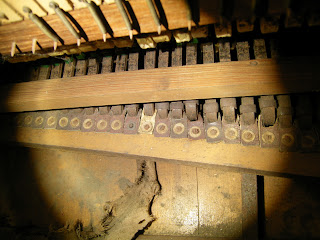For the uninitiated or the lazy the dulcitone was designed and manufactured in Scotland in the late 19th and early 20th century. By about 1915, production was halted as either popularity waned or impracticality of mass production and portability had the final word. Not being the loudest of acoustic instruments, its characteristic timbre was ultimately better sought by composers and ensemble arrangers in the louder vibraphone or celesta.
Photo: Andreas E Beurmann
What does the instrument sound like? To my ears, a lot like an acoustic version of a Fender Rhodes electric piano with a special warmth in tone somewhat lacking in say, the celesta. Of the 2000 odd manufactured, very few are in existence today and even less in passable working order. I suspect that this something to do with the rather bold claim that they were "portable", with fold-able legs allowing for transportation but rather delicate innards to be entirely suited to the rigors of the missionary's ox wagon.
Those delicate innards are best described with the aid of the following diagram courtesy of Sue Mo from her informative website.
In short, a hammering system, not unlike that of a grand piano, was employed to disengage a damper and strike a steel u-shaped tuning fork (which was responsible for the beautiful bell-like tone) which was held in place by oblong leather pieces. These maintained sufficient tension on the forks which rest on u-shaped sheet metal springs.I have made one minor alteration to Sue's diagram above in blue. There is additional felt that may or may not come into contact with some of the tuning forks (certainly some of the larger heavier ones) and this seems to ensure that there is minimal rattle when they are struck by the hammers. As can be seen from the diagram above, a rather intricate series of felted surfaces, springs and even a simple cam work in concert to enable the whole mechanism to work perfectly and noiselessly.
A foot operated pedal can be used to disengage damping entirely allow for more sustain when playing.
A foot operated pedal can be used to disengage damping entirely allow for more sustain when playing.





